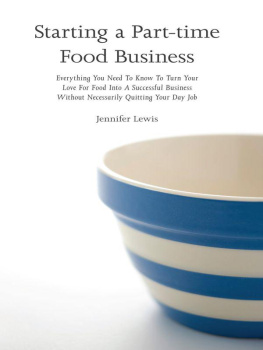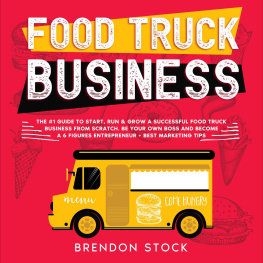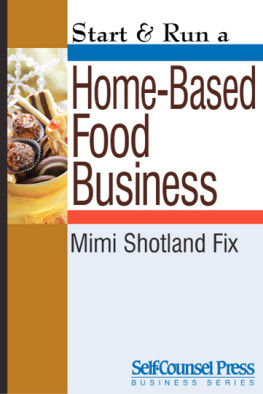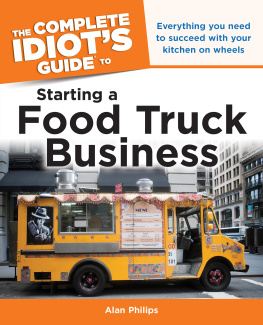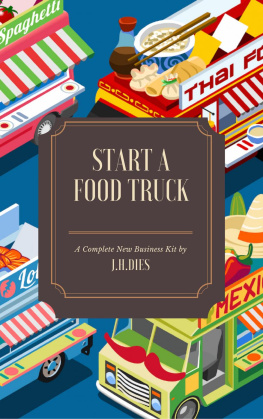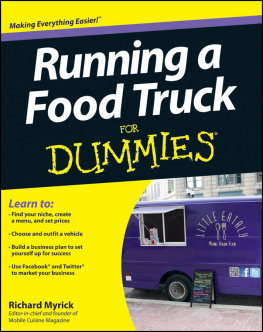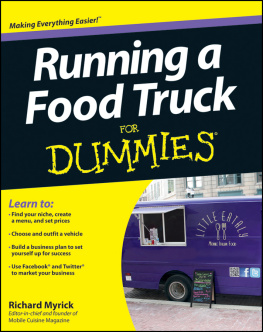All rights reserved. No portion of this book may be reproduced, stored in a retrieval system, or transmitted in any form or by any means without the prior written approval of the publisher.
Digital book(s) (epub and mobi) produced by: Kimberly A. Hitchens,
My deepest thanks to the food entrepreneurs mentioned in these pages and others without whom neither this book nor my own business would have survived all the ups and downs; To Bryan for always listening when I say SoI have an idea; And to my parents who always told me to reach for the cookies.
Go confidently in the direction of your dreams. Live the life you have imagined.
FOOD IS PASSION
In 2003 I was working my way up the corporate ladder, doing everything I was supposed to in order to succeed. Yet I felt unfulfilled and, truthfully, bored out of my mind. My day-to-day corporate responsibilities no longer excited me and I desperately wanted to do something different. I burned through countless hours sitting in my cubicle staring at my computer while daydreaming about opening a bakery. I even had a name picked out and menu items drawn up for my imaginary bakery. Baking has always brought me a tremendous amount of satisfaction and I've always loved the art of creating something by hand that other people eat and enjoy.
The reality, however, was that opening up a bakery just wasn't an option. I didn't have the finances necessary to open and run a bakery and I didn't want to put my entire life on the line with a enormous bank loan or run up credit card debt to fund my dream. I needed my current salary in order to make ends meet, so giving it all up wasn't something I was realistically able to do.
Or was there an alternative? It took a few years but I eventually realized that it was possible to work for someone else and work for myself at the same time. I knew it wouldn't be easy, but it would give me a creatively-fulfilling life while continuing to earn a steady paycheck. It was a way, in a sense, to try the bakery world without having to entirely give up my financial security.
Five years ago I started my specialty food company and am currently running it myself while simultaneously working for a nonprofit organization. Personally I feel this provides the best of both worlds. My business affords me the creativity that comes with making a specialty food product as well as the latitude to make important business decisions without having to go through multiple layers of red tape. I get to use my imagination on a daily basis when developing new products and flavor combinations. At the same time, my day job helps me feel that I'm making a difference in an organization. I also like knowing that every two weeks I'll earn a paycheck so that sales fluctuations in my own food business won't leave me with plenty of cash one month and broke the next.
Whether you're slaving away in a cubicle while daydreaming of turning your mother's secret jam recipe into the next it food or wish you could turn your flare for flan into a moneymaking venture that doesn't conflict with your stay-at-home parenting responsibilities, it's possible to start and run a successful part-time food business. Best of all, a part-time food business doesn't mean you can't one day grow the business into a full-time job if you want. By taking it slowly and growing a strong and loyal customer base, your part-time food business can grow into whatever you want it to be when and if you're ready.
In the interest of full disclosure, I have both a culinary degree and an MBA but the fact that you may not have either shouldn't stand in the way of your food entrepreneur dreams. Many of the most successful food entrepreneurs some of whom will be featured in these pages didn't have formal culinary or business training before starting their businesses. This book will take you through the steps necessary from testing your recipes to setting up a workable business plan to specific laws governing food businesses to start and run a successful part-time food business.
A note about how this book is organized. Most business professionals will tell you to write a business plan prior to obtaining business licenses or trying to find a place to sell your product. However, it's impossible to build a strong and reliable business plan until you fully understand all the components that go into it. This book places the business plan section towards the end with the aim of taking you through all aspects that will go into the plan before you actually write it. You may find it useful though to start drafting notes as you go through each section of this book so that when it comes time to write the business plan you already have a working outline you can draw from. A recommended Business Startup Checklist is available in the Appendices.
BEFORE YOU LEAP
A passion for cooking and/or baking is important and it will get you far, but many people have an overly romantic picture of what running a food business entails. Do you envision yourself daintily putting flourishes onto cakes? Then also envision yourself hauling around 50lb bags of flour. Can you see yourself making the perfect roast chicken for customers? Now see yourself making 101 roast chickens and ask yourself if you're still excited about roasting chickens. Finally toss in the fact that a food career requires you to stand for hours on end, you'll be covered in various ingredients, and your hands will look like.well, like you work with your hands.
Cooking for money is much more physically draining then simply baking a batch of cookies at home. So before you head down this path, honestly ask yourself if you are up for the physical nature of this line of work. If things go well you will go home at night tired and aching and you'll likely build up all kinds of arm muscles you never knew you had.
On the flipside, starting up a part-time food business is the perfect way to see if this new path is the right one for you. It requires a relatively low financial investment and it gives you the opportunity to test out your ideas and recipes on real customers. It will also give you a chance to test yourself to see if the reality of kitchen work lives up to the fantasy you have in your head.
HOW THEY GOT THEIR START
SVEDALA BAKERY
After a nation-wide search for fika turned up empty-handed, Svedala Bakery was born. Claes Bavik, a Swedish national, and his wife Kristina, a US citizen, had recently returned to the United States after several years working abroad in Europe and were craving a taste of home. Specifically, they were searching for fika which is a combaintion of treats that are eaten with coffee throughout the day. In Sweden it would be considered an insult not to offer a guest coffee and at least one of the fika treats, Kristina says.
After moving to Seattle, a city with a large Nordic population, Kristina and Claes combed the city in search of their favorite delicacies. Despite the fact that area stores sported Swedish flags and signs promised Swedish goods, what little they found could be classified, at best, as Danish. It's a very different flavor combination from Swedish goods, Kristina says.
Disappointed by their search, they went online and what they found available in the US was nothing like they could get back in Sweden. With nowhere else to turn, they started trying to recreate their favorite treats in their home kitchen. The friends they shared their goodies with urged them to open a Swedish bakery and they realized that they weren't the only ones who missed the flavors of home. Plus, the strong coffee culture of Seattle was reminiscent of the role coffee plays in Sweden so they believed their treats would be enjoyed by non-Swedes as well. It seemed like a good fit so they decided to start Svedala Bakery.

